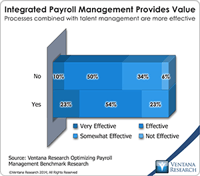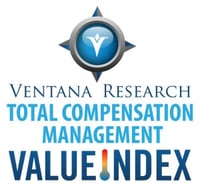This year Oracle OpenWorld conference opened with a fiery speech by Larry Ellison, who has stepped down from his role as CEO to become Executive Chairman and CTO. Filling his rhetoric with claims of market leadership and attacks on competitors SAP and Workday, Ellison set an aggressive tone for those who followed him. In a talk relevant to my research practice, Chris Leone, senior vice president of applications development, asserted that Oracle is making progress in human capital management...
Read More
Topics:
Mobile,
Social Media,
HCM,
Human Capital Analytics,
Human Capital Management,
Core HR,
Employee Engagement,
Platform as a service,
TM,
Wellness,
Analytics,
Business Collaboration,
Cloud Computing,
Collaboration,
Mobility,
Oracle,
HRMS,
Talent Management,
Social,
PaaS
ADP recently held its annual analyst day in the company’s new innovation center in the Chelsea district of Manhattan. The location emphasized what ADP wanted to get across to the analyst community at the event: that it intends to become a significant vendor of human capital management (HCM) software based in the cloud. ADP hopes to broaden its business from being largely an outsourcing vendor of payroll and related services (such as for auto dealers) to one that provides software for a range of...
Read More
Topics:
Big Data,
Mobile,
Social Media,
HCM,
Human Capital Management,
Office of Finance,
Predictive,
Analytics,
Business Analytics,
Business Collaboration,
Business Intelligence,
Cloud Computing,
Mobility,
Workforce Performance,
compliance,
HR,
HRMS,
Healthcare Compliance
Now available from Ventana Research is our Value Index on Total Compensation Management for 2014. Total compensation management directly addresses one of an organization’s largest investments – employee pay. As such it is a critical activity for supporting other human capital management and talent management processes.
Read More
Topics:
SAP,
Human Capital Management,
Kenexa,
Peoplefluent,
SuccessFactors,
Decusoft,
Towers Watson,
Analytics,
Business Analytics,
Business Collaboration,
Cloud Computing,
Financial Performance,
IBM,
Mobility,
Oracle,
Workforce Performance,
Compensation,
SumTotal Systems,
TCM,
Value Index,
beqom,
Pay for Performance
Ventana Research recently released our Value Index on Workforce Management for 2014. We define workforce management as the set of processes by which organizations manage their hourly and salaried employees to maximize productivity. It involves not only tracking time worked and providing compensation for it but also aligning that work to the objectives of the organization and to the individual employee’s needs. Our Value Indexes are informed by more than a decade of analysis of how well...
Read More
Topics:
Sales Performance,
SAP,
Social Media,
Human Capital Management,
Kronos,
Empower,
Operational Performance,
WFM,
Analytics,
Business Analytics,
Business Collaboration,
Business Intelligence,
Business Performance,
Cloud Computing,
Customer & Contact Center,
Mobility,
Oracle,
Workforce Performance,
Ceridian,
Infor,
SumTotal Systems,
Value Index,
Workforce Management,
Workplace
Adoption of workforce analytics is increasing as organizations seek to recruit and retain employees more effectively and ensure that their people deliver the productivity they expect. According to our benchmark research on the topic, 89 percent of organizations want to make it simpler to provide workforce analytics, which is not surprising as our analysis shows that only 12 percent of organizations have reached the highest level of maturity here.
Read More
Topics:
MicroStrategy,
Human Capital Management,
Kronos,
Research,
Business Analytics,
Business Collaboration,
Business Mobility,
Business Performance,
Cloud Computing,
Financial Performance,
Governance, Risk & Compliance (GRC),
Mobility,
Workforce Performance,
HR,
HRMS,
Talent Management,
Workforce Analytics
This week Peoplefluent announced that it has invested in Socialtext, a company that provides social collaboration software at the enterprise level. With this strategic investment Bedford Funding, the private equity firm that owns Peoplefluent, is the direct beneficiary. Peoplefluent will extend Socialtext into the human capital management market while continuing to let the company meet the broader market interest in its offering. Peoplefluent has moved quickly to make this application and...
Read More
Topics:
Sales Performance,
Social Media,
Sustainability,
Human Capital Management,
LMS,
Peoplefluent,
Performance,
Recruiting,
Research,
SocialText,
Business Analytics,
Business Collaboration,
Business Mobility,
Business Performance,
Cloud Computing,
Financial Performance,
Governance, Risk & Compliance (GRC),
Information Applications,
Information Management,
Mobility,
Workforce Performance,
Compensation,
HR,
HRMS,
Talent Management,
Workforce Analytics
Competition in the human capital management market rages on, with application suppliers racing to provide sophisticated applications that operate in the cloud. Cloud computing is a key factor in advancing human capital management, included in our research agenda for this area, along with analytics, collaboration, mobility and social media.
Read More
Topics:
Sales Performance,
SAP,
Social Media,
Sustainability,
Human Capital Management,
LMS,
Performance,
Recruiting,
Research,
Business Analytics,
Business Collaboration,
Business Mobility,
Business Performance,
Cloud Computing,
Financial Performance,
Governance, Risk & Compliance (GRC),
Information Applications,
Information Management,
Mobility,
Oracle,
Workforce Performance,
Compensation,
HR,
HRMS,
Talent Management,
Workday,
Workforce Analytics
The workforce analytics market continues to evolve as organizations seek to improve the time it takes to find insights and employer metrics in order to meet compliance requirements, mitigate risk and enforce governance policies. TALX, a subsidiary of Equifax, provides a range of data-oriented services that help HR, payroll and tax professionals. Its integration with eVerify service assists the hiring process with I-9 compliance, and capabilities to examine workforce compensation and financial...
Read More
Topics:
Sales Performance,
Social Media,
Sustainability,
eThority,
Human Capital Management,
LMS,
Performance,
Recruiting,
Research,
Business Analytics,
Business Collaboration,
Business Mobility,
Business Performance,
Cloud Computing,
Financial Performance,
Governance, Risk & Compliance (GRC),
Information Applications,
Information Management,
Mobility,
Workforce Performance,
Compensation,
HR,
HRMS,
Talent Management,
TALX,
Workforce Analytics
Businesses’ strategic imperative to optimize human capital is creating significant energy in the market for applications used to attract, optimize and retain talent. Amid all the recent acquisitions and changes that I have been writing about in this field, SumTotal Systems seems to get less attention than its size and the reach of its business merit. The company has more than 45 million users, with more than 15 million of them operating in a cloud computing environment spanning more than 3,500...
Read More
Topics:
Sales Performance,
Social Media,
Sustainability,
Human Capital Management,
LMS,
Performance,
Recruiting,
Research,
Business Analytics,
Business Collaboration,
Business Mobility,
Business Performance,
Cloud Computing,
Financial Performance,
Governance, Risk & Compliance (GRC),
Information Applications,
Information Management,
Mobility,
Workforce Performance,
Compensation,
HR,
HRMS,
SumTotal Systems,
Talent Management,
Workforce Analytics
Salesforce has begun to toot its marketing horn about its new capabilities for performance management through its acquisition of Rypple, a provider of software designed for social collaboration for improving employee engagement. I have already discussed this acquisition (See: Salesforce.com looking for a Successful Rypple in Human Capital Management) and have actually signed up for and used the software. Rypple has introduced some great innovations to promote feedback and dialogue between...
Read More
Topics:
Sales Performance,
Salesforce.com,
Social Media,
Human Capital Management,
LMS,
Performance,
Recruiting,
Research,
SuccessFactors,
Business Analytics,
Business Collaboration,
Business Mobility,
Business Performance,
Cloud Computing,
Mobility,
Workforce Performance,
Compensation,
HR,
HRMS,
Jobscience,
Rypple,
Saba,
Talent Management,
Workforce Analytics













